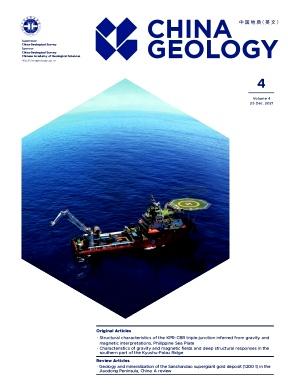Mesozoic multi-direction collision tectonic evolution of the Ordos Basin, China: Insights from the detrital zircon and apatite (U-Th)/He analyses
IF 4.7
3区 地球科学
Q1 GEOSCIENCES, MULTIDISCIPLINARY
引用次数: 0
Abstract
The Ordos Basin (OB) in the western part of the North China Craton (NCC), was located at the jointed area of multi-plates and has recorded the Mesozoic tectonic characteristics. Its tectonic evolution in the Mesozoic is significant to understand the tectonic transformation of the northern margin of the NCC. In this work, the detrital zircon and apatite (U-Th)/He chronological system were analyzed in the northern part of the OB, and have provided new evidence for the regional tectonic evolution. The (U-Th)/He chronological data states the weighted ages of 240–235 Ma, 141 Ma with the peak distribution of 244 Ma, 219 Ma, 173 Ma, 147–132 Ma. The thermal evolution, geochronological data, and regional unconformities have proved four stages of regional tectonic evolution for the OB and its surroundings in the Mesozoic: (1) The Late Permian-Early Triassic; (2) the Late Triassic-Early Jurassic; (3) the Late Jurassic-Early Cretaceous; (4) the Late Cretaceous-Early Paleogene. It is indicated that the multi-directional convergence from the surrounding tectonic units has controlled the Mesozoic tectonic evolution of the OB. Four-stage tectonic evolution reflected the activation or end of different plate movements and provided new time constraints for the regional tectonic evolution of the NCC in the Mesozoic.
鄂尔多斯盆地中生代多方向碰撞构造演化:来自碎屑锆石和磷灰石(U-Th)/He分析的启示
鄂尔多斯盆地位于华北克拉通(NCC)西部,处于多板块的接合区,记录了其中生代构造特征。它在中生代的构造演化对认识北陆北缘的构造转变具有重要意义。本文对鄂西北段碎屑锆石和磷灰石(U-Th)/He年代学进行了分析,为区域构造演化提供了新的依据。(U-Th)/He年代学数据表明,加权年龄为240 ~ 235 Ma、141 Ma,峰值分布为244 Ma、219 Ma、173 Ma、147 ~ 132 Ma。热演化、年代学资料和区域不整合面证明了塔里木盆地及其周围中生代区域构造演化分为四个阶段:(1)晚二叠世—早三叠世;(2)晚三叠世—早侏罗世;(3)晚侏罗世—早白垩世;(4)晚白垩世-早古近纪。研究表明,来自周边构造单元的多向辐合控制了OB的中生代构造演化,四个阶段的构造演化反映了不同板块运动的激活或结束,为NCC的中生代区域构造演化提供了新的时间约束。
本文章由计算机程序翻译,如有差异,请以英文原文为准。
求助全文
约1分钟内获得全文
求助全文

 求助内容:
求助内容: 应助结果提醒方式:
应助结果提醒方式:


